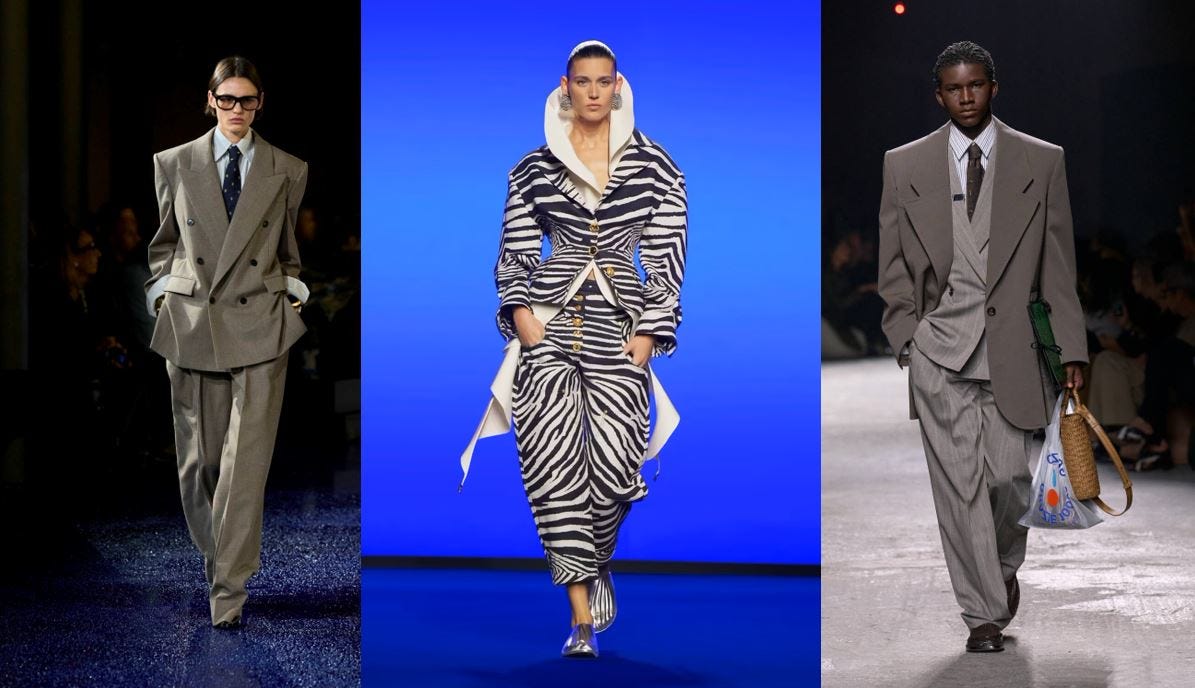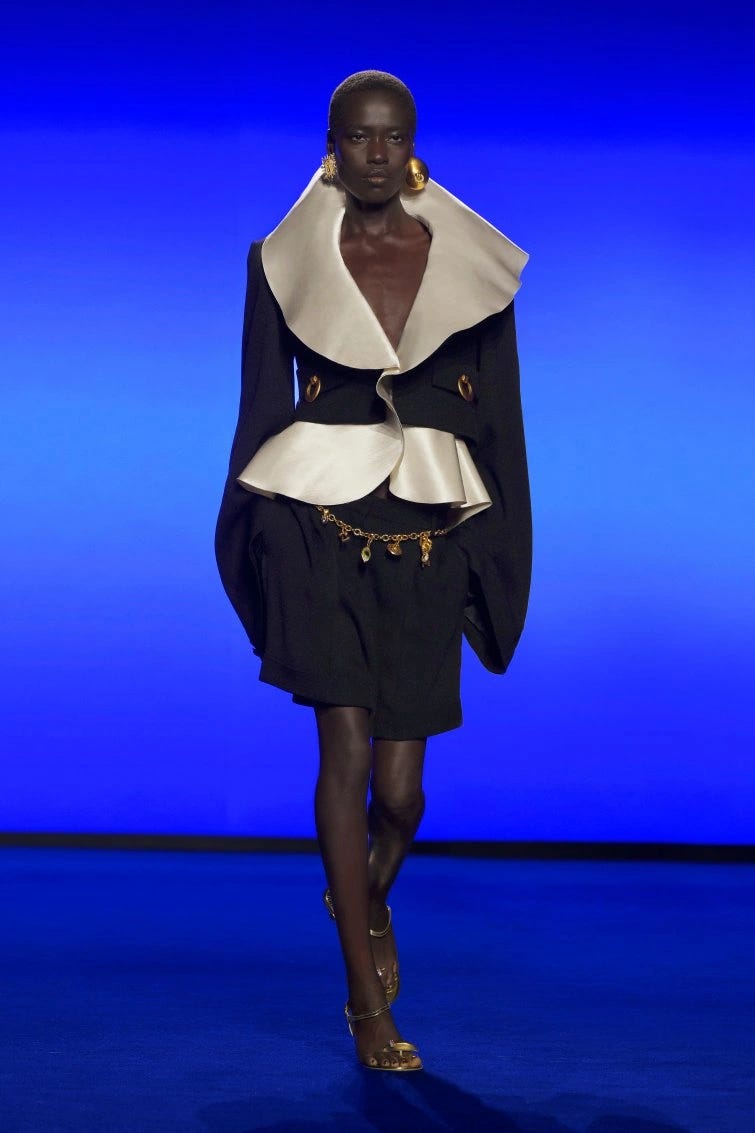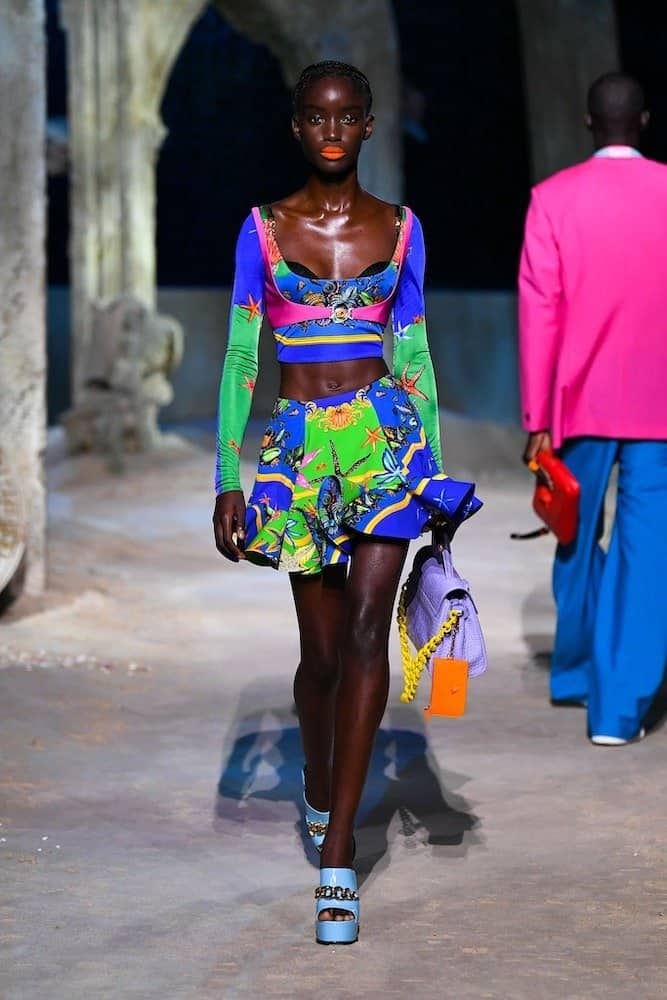Schiaparelli’s Spring-Summer 2025 show proves more is more: Why is power dressing coming back into fashion?
Padded shoulders and an abundance of gold; Schiaparelli’s SS 2025 show has triggered a revival of the 1980s power dressing sensation, but why is now the time to weave authority into our fashion?

The 1980s was a time for big. Big hair, big shoulders, big music and big impact. An era that is still reverberating down to our fashion today in 2024, in smaller, pocketable chunks. However, Schiaparelli’s Spring-Summer 25 show, designed by Daniel Roseberry, appeared to channel the power dressing of the ‘80s unreservedly, in a show that called upon past fashion movements to demonstrate their continuing relevancy today.
Schiaparelli indulged us with fashion’s first-class talent, including models Kendall Jenner, Irina Shayk, Candice Swanepoel and Adriana Lima, embellishing a show that spared no expense in its details. Every look was adorned with chunky gold accents, across the jewellery, as well as featuring on buttons in the clothing, belts, shoes and bag chains and straps. Dramatised silhouettes were created through figure-hugging corsets and exaggerated shoulders with oversized jackets and trousers.
For Roseberry, the show is celebratory, not just “of what fashion can be, but of how fashion can make you feel.” The cinched-waist blazers, shirts and ties that frame the collection, alongside thick, heavy-duty fabrics like denim, therefore characterise a form of power found in the fabric we wear. In the 1980s, after the peak of second-wave feminism in the 70s, women sought to shatter the glass ceiling, and invade male-dominated corporate and business environments. Women began to soar past the ceiling and reach high-level leadership roles, including Margaret Thatcher becoming the first female UK Prime Minister, and they were doing so whilst wearing a suit.
“Power suits didn’t whisper femininity, they roared it” – Vogue
John T. Molloy's 1977 book ‘The Woman's Dress for Success’ assisted the birth of power dressing in the ‘80s. Doubled breasted outlines and padded shoulders made the figure appear more imposing, giving women the confidence to unforgivingly barge their own suit-shaped space into the corporate environment.
The Schiaparelli show appears to reincarnate the spirit of the 1980s with gaudy jewel-encrusted necklaces and a brazen choice of zebra-print power suits and bags that make it impossible to gaze away. However, Roseberry refreshes the ‘80s era for a 2024 audience. The collection suggests that modern power dressing doesn’t have to take a masculine form to symbolise confidence, but rather celebrates power and femininity synonymously. Gauzy, sheer fabrics and glimmering silks cushion the show, and the deliberate choice of muted colours, featuring beiges, blacks, creams, yellows and browns establish a soft, summery, warm vibe. The final three looks, colourful fabric mosaics of florals, cement femininity within ability and strength.
So why is power dressing back in trend? Whilst in the ‘80s, it became a material way of emerging into the male-dominated workplace, today, power dressing takes on a form of self-expression; a method of personal branding. Whether it involves experimenting with traditional gender norms in fashion pieces, or adopting new statement trends such as the ‘Old Money’, ‘Preppy’ style, each choice sends a declaration about your individuality and choice, perhaps the biggest message of power. In a world where so much seems to be out of our control, from climate change worries and pandemic scares to economic crises and territorial tensions in the Middle East and Ukraine, our clothes are one thing we have authority over. Daniel Roseberry reinstates this: his Spring-Summer Ready to Wear designs are “celebratory”, despite the world feeling “more chaotic than ever”.
It's not just Schiaparelli that are sewing in the shoulder pads. This is a phenomenon that is flooding the runways. Saint Laurent SS25 show saw supermodels like Bella Hadid tearing down a dark and moody runway in an XXL-fit suit, complete with a shirt and tie. Bottega Veneta’s Spring-Summer 25 Ready to Wear designs also didn’t shy away from the sharp linear contours of the power suit, with a catwalk that intertwined male and female fashion, blurring the lines of gender in clothes. Even Versace brought back nauseating neons and violently flashy patterns, token of the 1980s, in their SS21 Ready to Wear show.
The 1980s revival is here, over 40 years later. Roseberry wanted his Schiaparelli designs to outlast generations: “[it’s] not just for our clients, but for their daughters and granddaughters,” authenticating the cyclical nature of fashion. Fashion trends return, and so do the concepts behind them. Although power dressing may take on a new form in today’s society, a power suit will never not be a choice of confidence.
The added padding might just take some of the weight off your shoulders.



